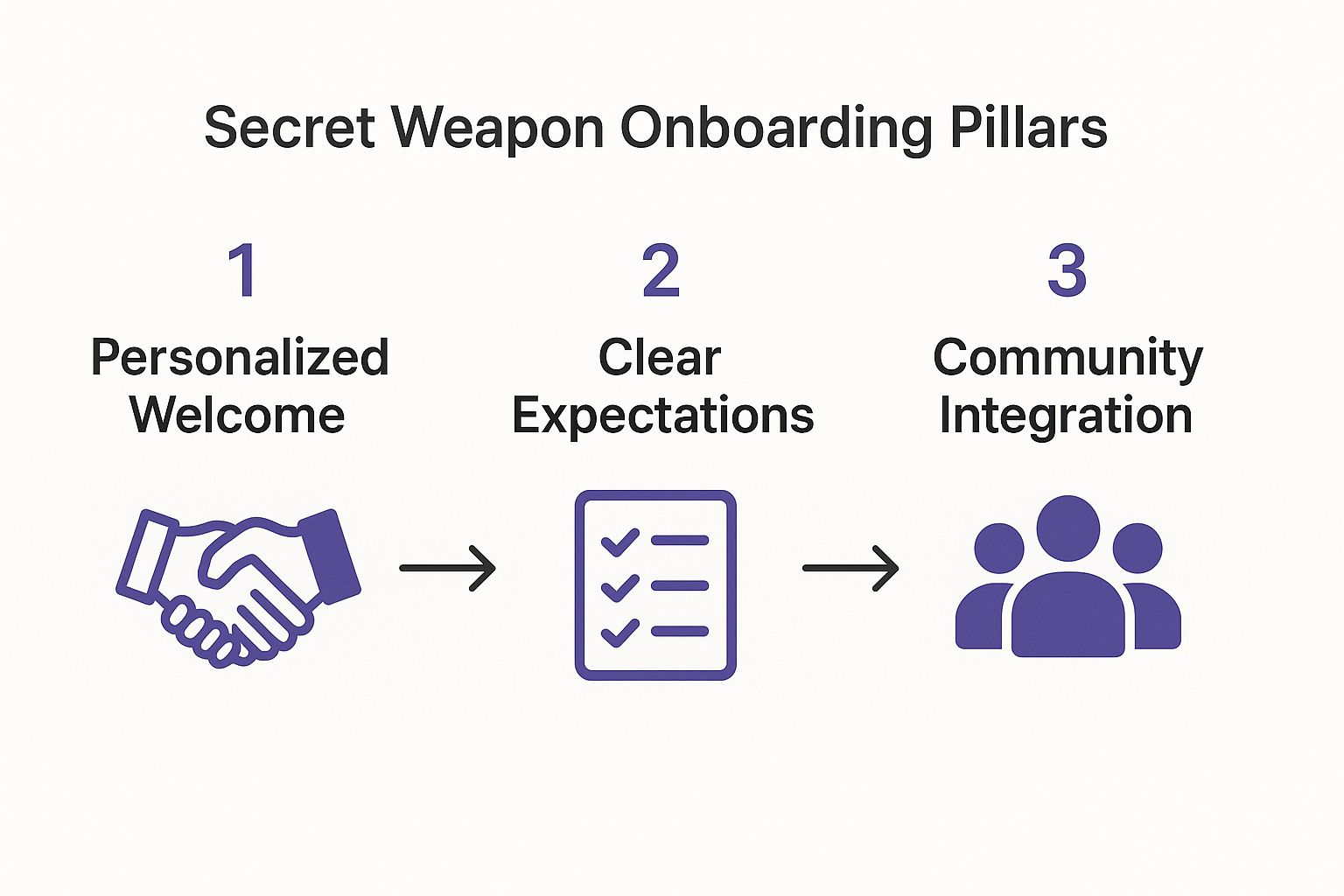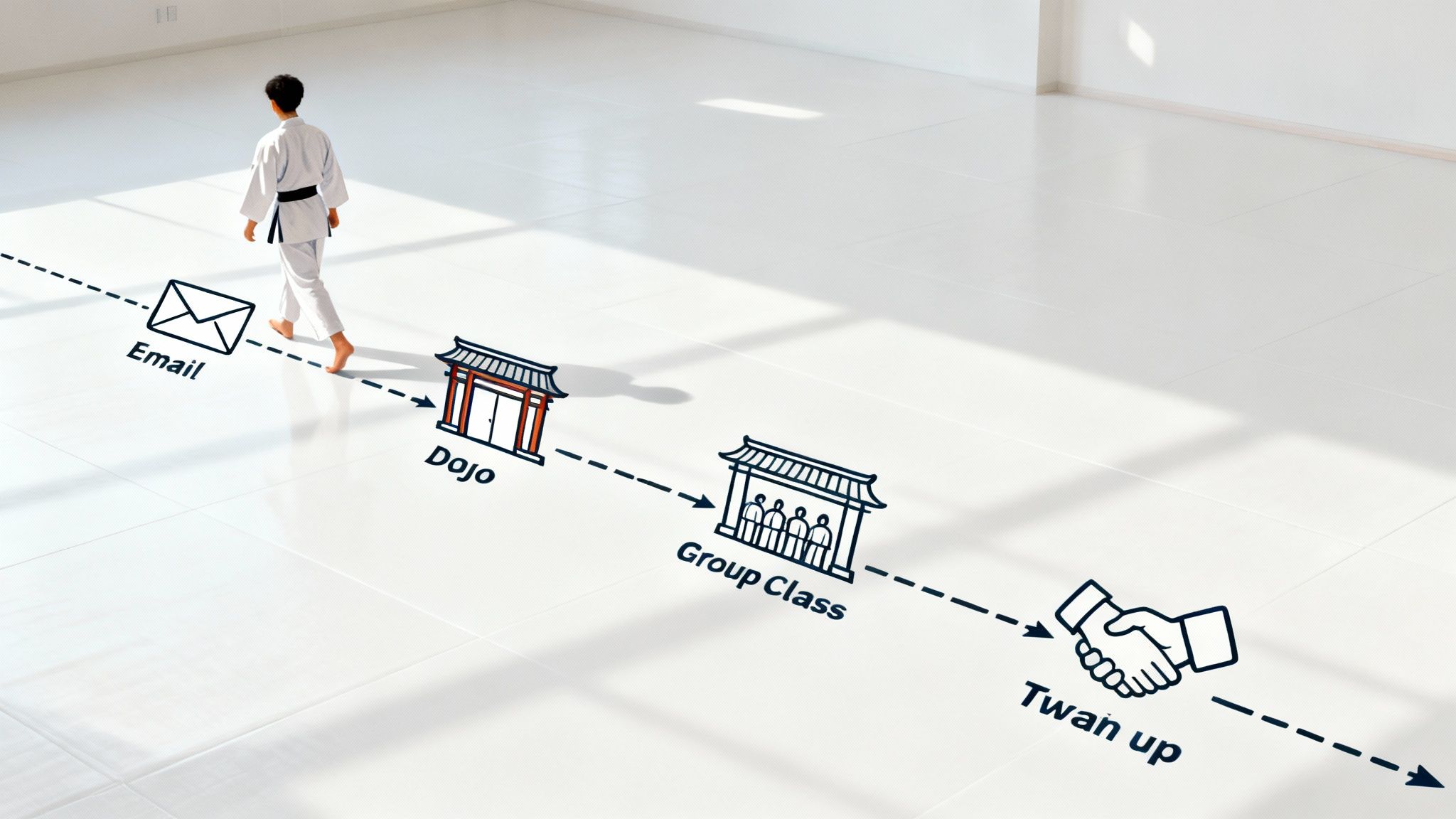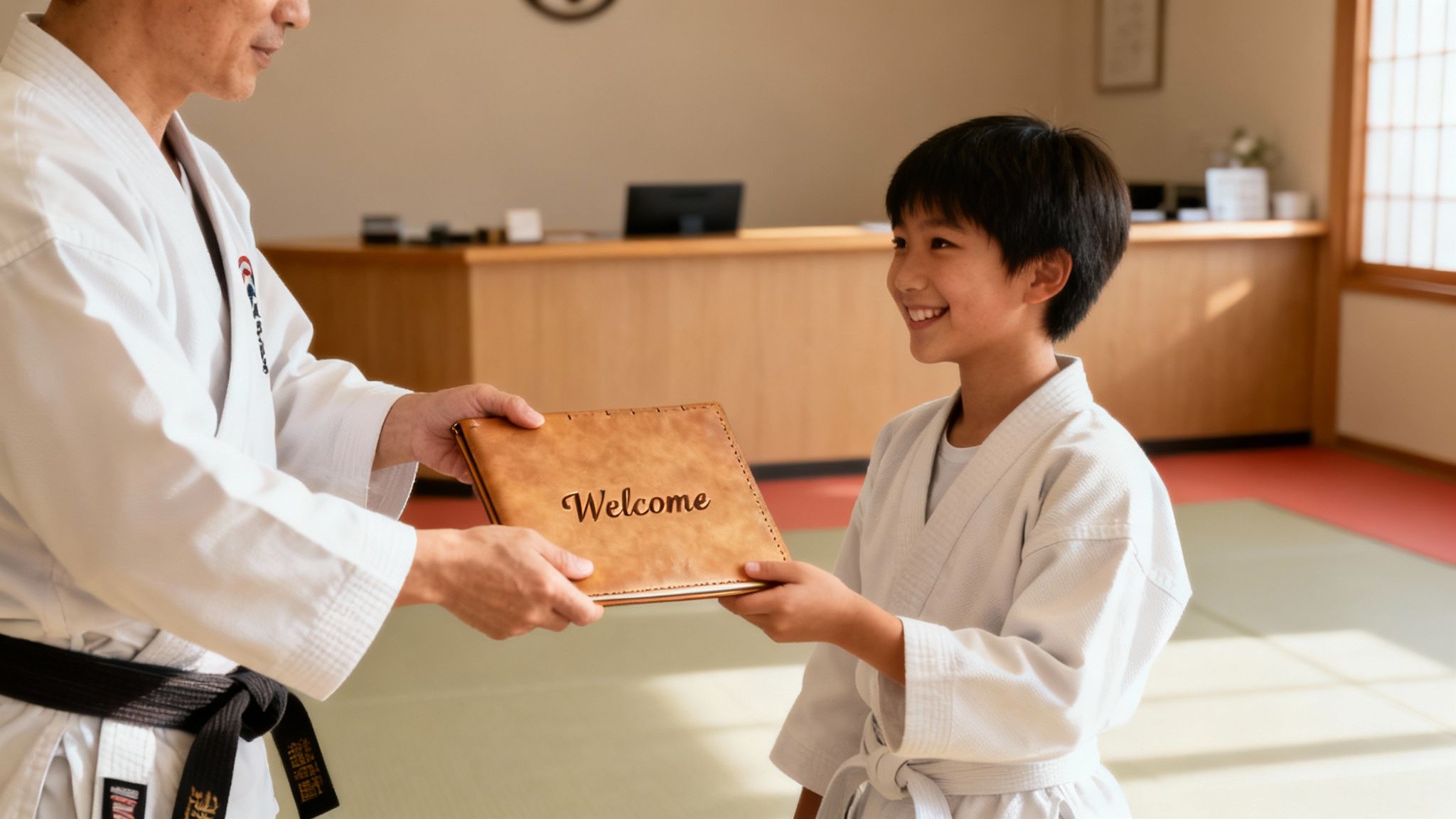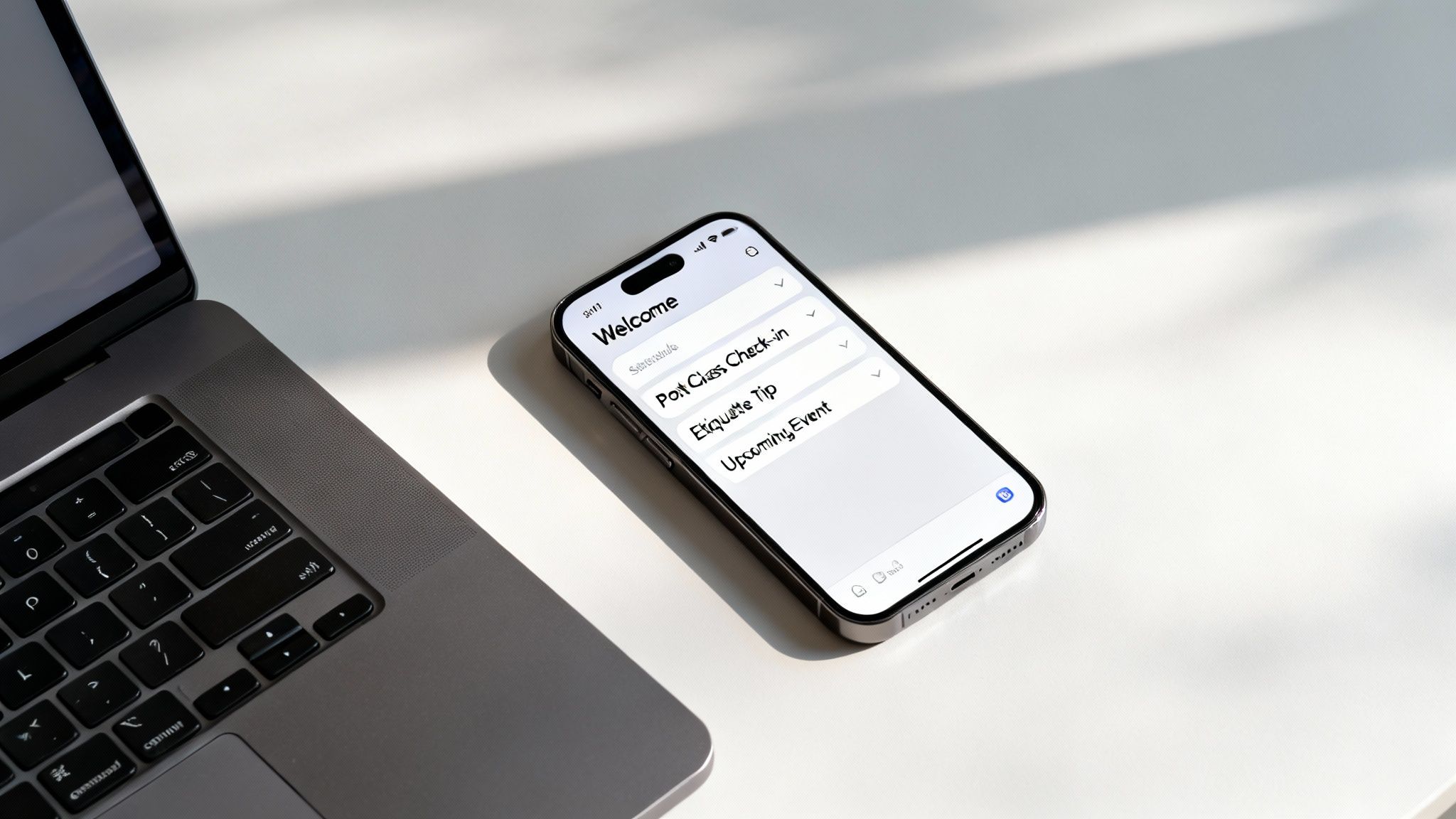

Discover how to improve your customer onboarding process with proven strategies to boost retention and grow your martial arts school. Learn more now!
Getting a new student to sign up is only half the battle. We all know that feeling of excitement when a new member joins, but the real work—and the real opportunity—starts the moment they walk out the door after signing up.
This is where your onboarding process becomes your secret weapon for turning that initial enthusiasm into a long-term commitment.
The first few weeks of a new student's journey are absolutely critical. Think about it from their perspective: they might be nervous, unsure of the etiquette, and wondering if they've made the right choice. A great onboarding experience smashes that uncertainty and replaces it with confidence.
Get this part right, and you'll see a massive impact on:
A powerful onboarding system isn't just a welcome email. It’s a deliberate sequence of touchpoints designed to make every new member feel seen, prepared, and connected to your school’s community.
This infographic really breaks down the flow of an effective onboarding experience.

As you can see, the journey starts with a personal touch, moves toward clarity and setting expectations, and finishes by integrating them into your community. Mastering this flow turns your welcome process into a powerful retention machine.
At its core, a strong onboarding experience is built on three fundamental pillars. Get these right, and you'll build loyalty from the very first class.
The table below breaks down these core components and gives you a practical look at how to implement them.
By focusing on these three areas, you proactively address the common reasons new students drop out: feeling lost, confused, or disconnected. You're not just teaching them martial arts; you're showing them they've found their new home.
Don’t just take my word for it. The data backs this up. A recent study found that 86% of customers said a welcoming and educational onboarding experience was a direct factor in their loyalty. That’s a massive number, and it proves that putting real effort into a structured start pays huge dividends.
For a deeper dive into the numbers, you can check out the full research on customer onboarding statistics.
Your goal is simple: ensure no new student ever feels lost or ignored. A well-designed process makes them feel like part of the family before they've even mastered their first form.
Of course, this isn't a one-person job. Your entire team, from the front desk to your assistant instructors, plays a huge role. Getting everyone on the same page is crucial for delivering a consistently great experience. For more on this, check out our guide on training the staff for your martial arts school.

To really nail your onboarding, you have to stop thinking like a school owner and start thinking like a brand-new student. What does their experience actually feel like from the moment they pay their first month’s dues to when they step off the mat after their third class?
Mapping this journey is how you get ahead of the game. It lets you proactively design an experience that swaps out that new-student anxiety for genuine excitement.
Don't overthink it. A student journey map can be as simple as a whiteboard or a spreadsheet. The key is to identify every single touchpoint a new member has with your school in their first 30 days. Be brutally honest about what really happens at each stage.
This simple exercise forces you to see beyond your own assumptions and pinpoint the exact moments where a student might feel confused, ignored, or overwhelmed. It's all about taking control of the narrative and making sure every single interaction is intentional.
Your map needs to include everything—every email, every text, every in-person interaction. Each one is a chance to build trust and make a great impression.
Start by just listing them out. It might look something like this:
Once you have these points laid out, you can start designing the ideal interaction for each one. This is the foundation for an onboarding experience that people will talk about.
For each touchpoint, ask yourself two questions: "What do I want the student to feel?" and "What specific action do I need to take?"
Let’s look at a few common examples and how you can seriously level them up.
The Payment Confirmation email should be 100% celebration. This isn’t the time for logistics or class schedules. A simple, "Welcome to the family, [Student Name]! We are so excited to have you," sets an immediate positive and welcoming tone.
Next up, your Pre-Class Communication is where you handle all the practical stuff. This is your chance to answer the questions they haven't even thought to ask yet.
Proactively addressing common anxieties is one of the most powerful things you can do. A simple message detailing what to wear, where to park, and what to expect can completely change a new student's mindset from nervous to prepared.
Finally, the First Arrival is a moment of truth. Is there a designated staff member ready to greet them by name? Do they get a quick tour of the facility? Are they introduced to their instructor before class begins? These small, personal gestures make a massive difference. They make someone feel like they belong, not like they're just another transaction.

A generic welcome packet is forgettable. A personalized one? Unforgettable. This is your chance to make a new student feel like they're the only student, turning their first interaction from a simple transaction into a real connection. If you want to nail your onboarding process, you have to move beyond one-size-fits-all communication.
This all starts the moment they sign up. Your digital registration form isn't just for collecting contact details; it's your first opportunity to gather crucial intel. Adding a few simple, optional questions can give you everything you need to blow them away.
You can learn so much just by asking the right questions. Think about adding these fields to your sign-up form to get a handle on their unique needs and motivations right away:
This data isn't just for your files; it’s the fuel for creating a truly memorable welcome. It shows you're paying attention from day one.
A personalized experience isn't just a nice-to-have; it's a critical part of modern onboarding. Research shows 58% of customers feel that receiving a personalized experience is absolutely crucial during this phase.
This initial effort has a huge payoff. When 63% of customers say the onboarding period is a major factor in their decision to commit to a service, personalization becomes one of your most powerful retention tools.
Now, it's time to use that intel. A student who mentioned their goal is "fitness" could get an automated welcome email with a line like, "You're going to love the conditioning warm-ups in our adult class!" Simple, but effective.
Or what about the parent of that shy child? Imagine the impact of a personal text from the kids' class instructor: "Hi [Parent's Name], this is Sensei John. I saw that [Child's Name] might be a little nervous. I'll be sure to greet them at the door and introduce them to another student, Maya. We can't wait to meet them!"
This level of detail shows you care and builds immediate trust. It proves you're running a professional, attentive school. Even your initial digital touchpoints matter here; for instance, designing a website that builds trust sets the stage for a positive relationship from the very first click.
These small, thoughtful actions build a strong foundation, turning a new sign-up into a dedicated member of your community before they even step on the mat.

As your school grows, you simply can't be everywhere at once. And while nothing beats that personal, one-on-one interaction, scaling that high-touch approach becomes a serious challenge. This is where a little bit of smart automation becomes your best friend, helping you nail the customer onboarding process without losing that crucial personal connection.
The goal here isn't to replace yourself with a machine. It's about using technology to handle the repetitive, predictable communications. This frees you up to give that high-value, in-person attention on the mat where it truly counts.
Think of it as creating a safety net of helpful nudges and check-ins for every single new student. Whether you use dedicated martial arts school software or a simple set of well-organized email templates, you can design a communication flow that guides new members through those critical first few weeks.
A simple, time-based sequence of messages can work wonders. This ensures every student gets consistent, timely information that answers common questions right when they're likely to have them. This kind of proactive communication builds their confidence and shows you’re already thinking ahead for them.
Here’s a sample communication sequence you can steal and adapt for your own school:
This structured approach guarantees no one falls through the cracks. It systematizes the check-ins you'd ideally do in person but might miss during a crazy week. You can learn more about the key benefits of business process automation and how it can help you get these tasks off your plate for good.
The single biggest mistake people make with automation is sounding like a robot. The key to making this work is injecting your personality and genuine voice into every single message. Your automated emails should sound like they came directly from you, not a machine.
The goal of automation is to scale your personal touch, not eliminate it. Every automated message should feel like a helpful, one-on-one conversation that anticipates a student's needs.
To pull this off, always write your copy with a single person in mind. Use their first name, keep the language conversational and friendly, and don't be afraid to use emojis if that fits your school's culture.
Instead of writing, "Your attendance has been noted," try something much warmer like, "Great seeing you on the mat tonight, [Student Name]! You crushed it." That small shift in tone makes all the difference. It turns a cold, impersonal notification into an encouraging pat on the back.
You’ve mapped out the perfect new-student journey and automated the key touchpoints. Fantastic. But how do you know if it’s actually working?
To really dial in your onboarding process, you have to stop guessing and start measuring. Tracking the right data shows you exactly where your process shines and, more importantly, where new students might be slipping through the cracks. This isn’t about drowning yourself in spreadsheets. It’s about focusing on a few key performance indicators (KPIs) that tell you the real story about your new student experience.
When you know your numbers, you can make sharp, informed decisions instead of just going with your gut.
For a martial arts school, there are really three core metrics that give you a crystal-clear picture of your onboarding effectiveness. They're surprisingly simple to track but incredibly powerful in what they reveal about student satisfaction and long-term retention.
First-Month Attendance Rate: How often do new students actually show up in their first 30 days? A high attendance rate is a massive signal of engagement and excitement. If you see this number dipping, it’s an early warning that something in that initial experience isn't clicking.
90-Day Retention Percentage: This is the big one. What percentage of new students are still actively training three months after they sign up? This number is a direct reflection of how well you’ve integrated them into your school’s community and culture.
Direct Student Feedback: Numbers tell one part of the story, but honest feedback from your students tells the rest. Simply asking for their opinion is the fastest way to uncover frustrating little friction points you would have never seen otherwise.
The great news is that you can pull most of this data directly from the tools you're probably already using. Our guide to software for martial arts schools can point you toward systems that make tracking these metrics almost effortless.
Direct feedback is a goldmine of insights. A simple 30-day check-in survey, sent automatically by email or text, can tell you so much. You can whip one up for free using a tool like Google Forms.
Don't be vague. Ask pointed questions that give you real answers, like:
Another powerful tool is the Net Promoter Score (NPS), which basically just asks how likely a student is to recommend your school after their initial experience. A high NPS shows you’re not just keeping students; you’re creating loyal advocates who will help you grow. It's a simple question that reveals a whole lot.
Your goal isn't just to collect data; it's to find actionable insights. If several new students mention they were confused about the class schedule, that's a bright, flashing sign to update your welcome email. Acting on that feedback is what turns a good onboarding process into a great one.
Even with the slickest automation in place, you’re going to run into specific challenges when dialing in your new student onboarding. It just comes with the territory. Let's tackle some of the most common questions I hear from school owners, with some straight answers to help you troubleshoot your process.
Getting these details right is what separates an onboarding system that feels genuinely helpful from one that just adds to the noise.
This is a great question, and there's no single magic number. The sweet spot for an active onboarding process is anywhere from 30 to 90 days.
Think of it in phases. The first two weeks are your high-alert period. This is when a new student’s initial excitement is most fragile and when they’re most likely to drop off if they feel confused or disconnected. Your communication and support need to be at their peak here.
After that first month, you can start easing them into your standard member communication flow. But don't cut them off completely. Continuing to send targeted check-ins and community updates all the way to the 90-day mark really cements their place in the school. It sends a powerful message that your support doesn't vanish once the initial trial is over.
Automated emails, welcome kits, and check-in texts are all fantastic. But they're the supporting cast. The undisputed star of the show—the single most critical element—is the in-person experience during a new student’s first few classes.
No perfectly written email can undo the feeling of being ignored or overwhelmed on the mat.
The real magic happens when your instructors and staff become onboarding champions. They have to be trained to spot new faces, make introductions to other students, and offer specific, encouraging feedback. That personal touch is what makes people feel like they belong, and belonging is what makes them stay.
Absolutely. While dedicated martial arts school software makes automation and scaling a breeze, the core principles of great onboarding don't cost a thing. You can run a surprisingly effective system with tools you probably already use.
A simple spreadsheet can track new students and their journey. Calendar reminders can be your prompt to send a templated email or, even better, make a quick personal phone call.
Honestly, a consistent manual process that’s executed with care is infinitely better than a clunky, impersonal automated one. Start there. Prove the system works, get your reps in, and then look to software like Martialytics to help you do it for more people without losing your mind.
Simple: ask for it directly, and make it incredibly easy for them to give it. Don't wait until you notice they've stopped coming.
Send a super-short, three-question survey after their first 30 days. The timing is key. They’ve been around long enough to have a real opinion but are still new enough to remember the onboarding details vividly.
Ask pointed but easy questions that get right to the heart of the matter:
The answers you get back will be pure gold. More importantly, acting on that feedback is the fastest way to build an onboarding experience that turns new sign-ups into lifelong members.
Streamlining these processes, from communication to feedback collection, is exactly what Martialytics was designed for. Our software automates the tedious tasks so you can focus on creating those unforgettable in-person experiences on the mat. See how you can build a world-class onboarding system by starting a free 30-day trial.


No credit card required. No lock in contracts. Start your 30-day free trial to see immediate improvements.

Book your free demo with one of the co-founders of Martialytics, Brad or Allen, depending on your time-zone.
We'll do this on Zoom video conferencing software for awesome screen sharing so please make sure you have the app or are good to go before the time starts.